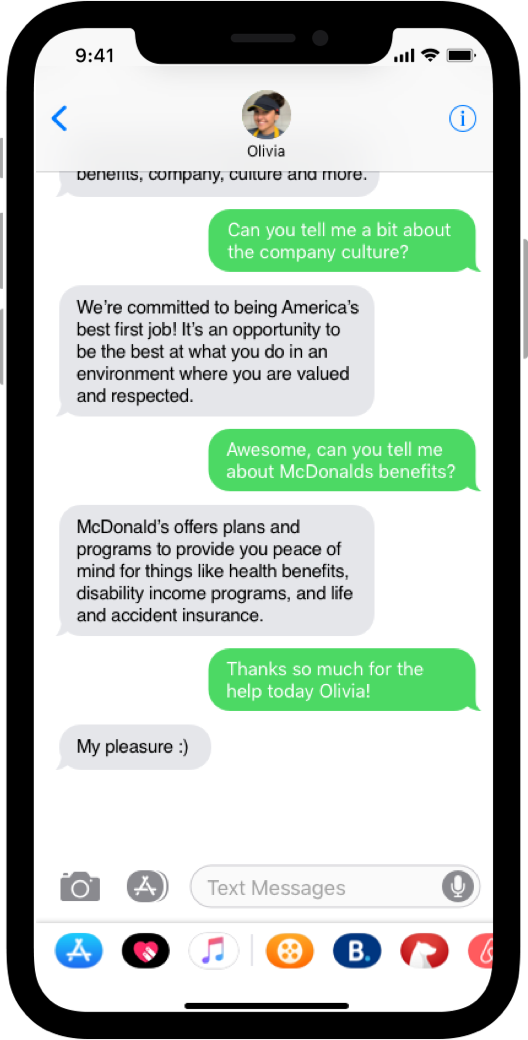-
Provided by

- Date published: Mar 20, 2023
- Categories
Artificial intelligence (AI) is transforming the world of business at an unprecedented rate. This technology is revolutionizing the future of work, from recruitment and employee engagement to learning and development. Indeed, despite the recent spike in popularity largely thanks to the public launch of ChatGPT in November 2022, many organizations and industries are already reshaping their workflows with the help of artificial intelligence.
With a deep history in organizational innovation, it’s no surprise McDonald’s is at the front of the queue. In 2019, it rolled out talent hiring platform from Paradox, re-branded as McHire, to company-owned restaurants, and offered the platform as an optional program to franchisees in the US and Canada. It has since adapted McHire for the UK and Ireland. As many organizations only just begin to consider how generative AI could reshape their full employee lifecycle, McDonald’s restaurants in the UK and Ireland are already reaping the rewards.
Following the introduction of McHire, 1,450 McDonald’s restaurants in the UK and Ireland have seen:
- Time-to-hire reduced by nearly 65%
- A 20% increase in the number of candidates completing the process compared to the previous system
- 85.9% of surveyed candidates rated their experience as four out of five or five out of five. (December 2022)
- Three to five hours of time saved per recruiter per week
Richard Bainbridge, People Technology Lead at McDonald’s UK&I, is part of a team formed specifically for this type of digital transformation. He takes us through the McHire journey.

Meet McHire, McDonald’s AI hiring platform
McHire is a talent-hiring platform that leverages conversational AI to create a shorter and more engaging candidate experience. This experience is driven by a recruiting assistant that is live 24 hours a day and reframes the application process for prospective candidates applying for roles in a restaurant. Bainbridge explains a typical journey for an applicant to the fast-food chain.
“We wanted the initial contact to feel engaging and conversational and not like filling out a traditional application form. When a candidate reaches out to register an interest in a vacant role, the AI assistant, Olivia, jumps in. It asks a number of pre-screening questions and gathers information and data on the candidate. They complete an interactive assessment that populates the application form. The system assesses their suitability for the role, and if successful, they are automatically set up for an interview at the restaurant they are applying for.
“It’s a much simpler, quicker, and easier process that’s more enjoyable for the applicant. And that was our thinking throughout, we wanted to ensure we were candidate-centric in our thinking while supporting our restaurant recruiters.”
McHire is a significant change to McDonald’s UK&I prior model for talent acquisition, having introduced its last system a number of years ago. It has seen a significant improvement in hiring times, the number of candidates completing applications and overall candidate satisfaction. Following the roll-out of McHire, average time-to-hire has dropped by nearly 65%. Restaurants have also seen a 20% increase in the number of candidates fully completing the job application process. 85.9% of surveyed candidates rated their experience as four out of five or five out of five. (December 2022)

Navigating the AI vendor selection process
As with any HR vendor selection process, choosing the right partner is paramount. The first stage of this process is diagnosing the challenge the technology, tool, or vendor needs to solve. With over 200 franchisees, creating a clear picture of the organization’s needs was paramount. Alongside digital consultancy and partner Enfuse Group, McDonald’s invested a significant amount of time in creating a cross-functional team across the business, to understand restaurant and recruitment challenges. Bainbridge outlines the huge scope of stakeholders involved in this process.
“To understand the challenges for our restaurants and what they wanted to move away from was essential. We needed to make a system that would work for the entire business, so we pulled together members from all areas of the business, bringing together what we refer to internally as the ‘Three Legs of the Stool’ —franchisees, suppliers, and company employees. The teams included Talent Recruiters, People Managers, franchisees, HR, technology teams, legal teams, finance, cyber security, and data analysts, who all came together to help us define what we needed. It was a complete deep dive into the current process.”
McDonald’s and Enfuse Group used these insights to create a Request for Proposal (RFP), for potential suppliers to put forward their solutions. The RFP yielded eight different solutions that McDonald’s quickly whittled down to four options based on functionality. The cross-functional team met with each vendor to understand their product and how it could be customized to fit McDonald’s.
“There were three parts to this process. Understanding each vendor’s business and future thinking, vendor demonstrations, and an open question and answer session with the cross-functional team. We also held ‘Commercial Clarification Calls’ to ensure that the pricing and costs submitted were aligned to the needs of the business.”
This resulted in a decision paper, and updated Business Case, which outlined the process, scoring, and rationale before being approved. This best practice has since been incorporated into McDonald’s People Technology ways of working for the future.

The roll-out of McHire
The difference between the theoretical application and practical adoption of tools and software is an uncomfortable reality for HR leaders to face. Software gathers dust when organizations select the wrong tool, but also when implementation and training are ineffective. Indeed, another vital component of McDonald’s success with McHire was the adoption of the system.
“You can have the best solution, but if it’s not adopted well in the restaurants, then that causes even more frustration. The business has really embraced the system. They’ve told us it was the step change they needed to support their recruitment needs in what is an extremely challenging and competitive market.”
Alongside support materials from the AI vendor, McDonald’s took a personalized approach to training. Moreover, the creation of a test environment for restaurants was vital in ensuring the adoption of the technology.
Customized training and community development
McDonald’s curated in-person sessions for smaller groups to come together and begin learning how to use this technology. It personalized the sessions, allowing each stakeholder to access training highly relevant to their job role.
“We adapt the materials for different audiences. From a franchisee’s point of view, would they be in the finer detail of the recruitment system? No, and we wouldn’t expect them to be, but we did want to take them on the journey and for them to understand how this technology will impact their business and the benefits it will deliver. The People Managers and recruiters needed the details and finer training, given the role they play using the system day to day.”
“And for change on this scale, we feel there’s nothing better than face-to-face training. It was the first time after Covid-19 we were reverting to in-person, and it worked extremely well. We had great buy-in across the business. People could break out into smaller sessions and share their experiences. We delivered over 30 face-to-face sessions across the UK&I for over 2,000 users and created open forums for people to ask questions and share their experiences. It became a community that helped each other adopt the technology, with the project team on hand to support through webinars, where needed.”
Developing a test environment
These sessions also included access to a testing environment. Ahead of the go-live date, restaurants, and key employees were able to access a secure environment to explore the way McHire works. This was augmented with a pilot scheme of 29 restaurants that initially went live and processed real-life candidates.
“It let people become accustomed to the system and experience the application process. It helped them understand what it was like in practice and gave them a chance to test and feedback, so we had the time to implement any changes ahead of the full deployment.”
This test-based approach has continued since the release of McHire, to constantly iterate and improve the platform. To date, over twenty user-led enhancements have been successfully rolled out since its launch to an estate of 1,450 restaurants.
“Our approach now is to ensure we only implement systems that we can continue to evolve. Through our ongoing engagement with our franchisees and restaurant teams, we work to understand how we can continually improve, sharing our feedback with the supplier, and road mapping enhancements to make sure the technology continues to add the value our restaurant teams need.”
AI enables rather than replaces
Bainbridge also highlights the role the franchisees have played in adopting this technology. With the support of the McDonald’s UK&I People Team, AI has helped franchisees to tackle their hiring bottlenecks, from locating quality candidates to securing the right quantity of applicants in the pipeline.
“AI is an important enabler of achieving what our franchisees and recruiters need. However, AI on its own won’t guarantee the right outcomes. Rather it needs to be implemented holistically across people, processes, policy, and data. Each restaurant has its own specific challenges and needs and McHire was able to support this, whether that be a high-volume restaurant with high recruitment needs or a hard-to-hire location the system has been a great fit for all.”
The introduction of this technology has freed up time for the recruiting team to focus on adding value in other areas. McDonald’s estimates each recruiter has saved on average three to five hours of time per week. Recruiting leaders are reinvesting this time into training and onboarding new joiners to support retention and delivering a great customer experience.

Why McDonald’s created a People Technology team
To support the ever-increasing people technology portfolio and the introduction of McHire and future software implementations, McDonald’s created its first People Technology team in the UK and Ireland. Previously, this work spanned across two different functions, People and Technology.
This team owns the strategic direction of the portfolio while being aligned to business needs, whether that be recruitment, scheduling, HR, or engagement.
Within that work, the team covers various responsibilities, including:
- Project Management. This complex change for McDonald’s required working with six third-party systems and myriad deadlines. The PeopleTech team partnering with Enfuse Group ensured that all the dependencies were managed effectively, risks and issues were resolved, and decisions were quickly but carefully made to avoid delays to implementation.
- Design & Configuration. A key part of encouraging adoption was creating an intuitive and simple process. All team members came together to ensure that the design was candidate-centric.
- Change Management. With the prior solution dating back to 2007, this was a huge change for the restaurant teams. The PeopleTech team worked closely with Enfuse Group and their own Change Team to manage the planned change that was delivered against project goals.
- Transition to business-as-usual. Once live, McDonald’s needed to ensure that the rollout continued to be a success. The People Technology team worked with franchisees and restaurants to resolve any issues and implement any further changes.
“We needed a team of people who proudly have one foot in technology, and another in restaurant operations. The team guides the business and engages with our franchisees on their work and systems that would help them succeed.”
“The team has done a huge amount of work to engage with every user of the system through phone calls, webinars, and surveys to solicit feedback. That includes our franchisees, our recruiters, and our new hires that have come through the system. We’ve even spoken with people that have completed the process and haven’t been hired.”

Where next for AI at McDonald’s?
With McHire rolled out in the US and Canada, and the UK and Ireland, McDonald’s and some of its franchisees are now beginning to scale the use of AI for hiring and HR processes across the globe. The journey to create a customized model for McDonald’s UK and Ireland is informing this process.
“I’m proud to say that McHire is a global solution adopted across many markets. We’re feeding and supporting global teams with our thoughts, experience, and lessons learned. There’s a working group to make sure this knowledge is shared and to ensure the system is right for each market. That includes legalities but also how processes work in each location.”
Moreover, with a proven user case in the UK and Ireland, and a dedicated People Technology team, McDonald’s is now turning its attention to other areas of the employee lifecycle and considering the impact AI may have.
“We are now focused on the next stage of the candidate journey, their onboarding experience. We are exploring how AI can support here, from the welcome meeting through to celebrating their first day and anniversary with us. There is clearly a huge amount of potential to explore here, and I’m looking forward to continuing to unlock it.”








